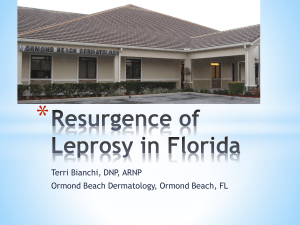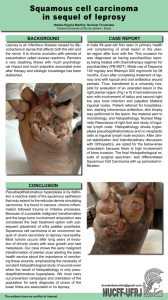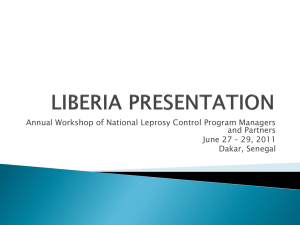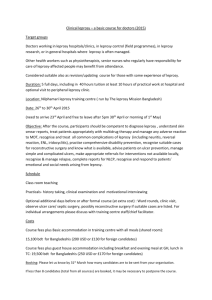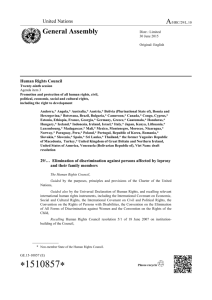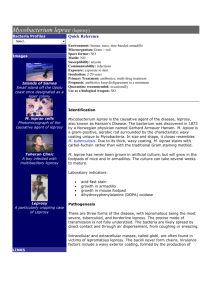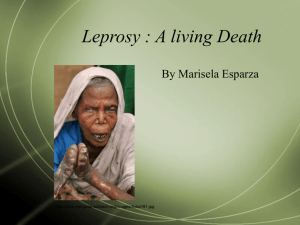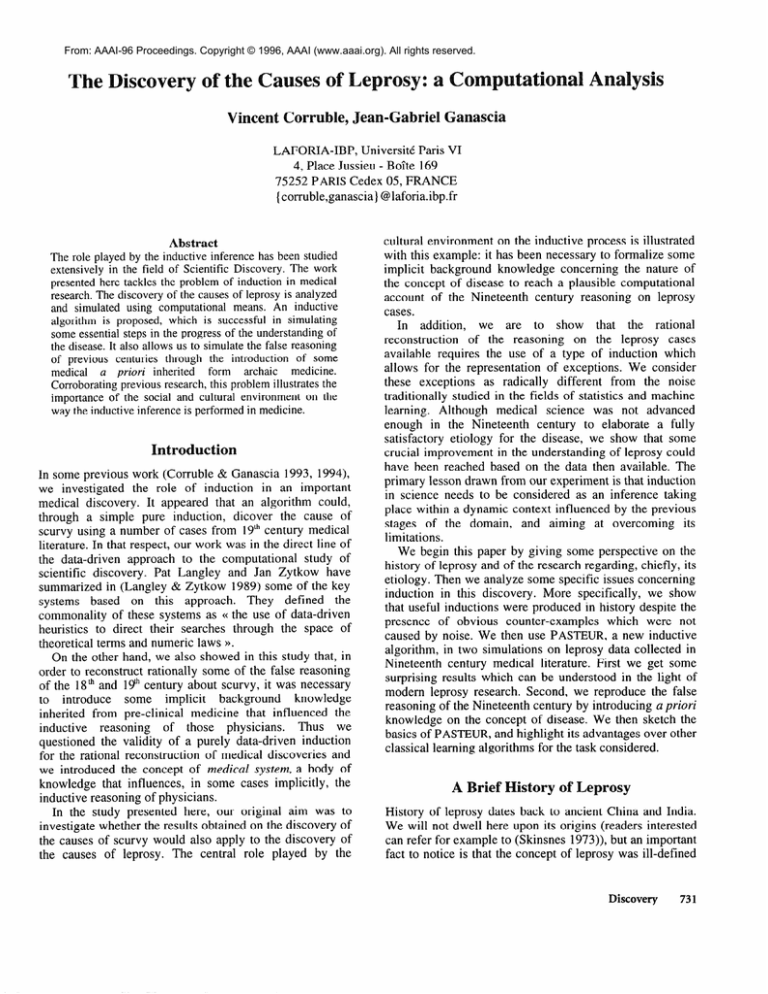
From: AAAI-96 Proceedings. Copyright © 1996, AAAI (www.aaai.org). All rights reserved.
ses
Vincent Corruble, Jean-Gabriel Ganascia
LAFORIA-IBP,
Universite Paris VI
4, Place Jussieu - Boite 169
75252 PARIS Cedex 05, FRANCE
{corruble,ganascia} @laforia.ibp.fr
Abstract
The role played by the inductive inference has been studied
extensively in the field of Scientific Discovery. The work
presented here tackles the problem of induction in medical
research. The discovery of the causes of leprosy is analyzed
and simulated using computational
means. An inductive
algorithm is proposed, which is successful in simulating
some essential steps in the progress of the understanding of
the disease. It also allows us to simulate the false reasoning
of previous centuries through the introduction of some
form
archaic
medicine.
medical
a priori inherited
Corroborating previous research, this problem illustrates the
importance of the social and cultural environment on the
way the inductive inference is performed in medicine.
Introduction
In some previous work (Corruble & Ganascia 1993, 1994)
we investigated
the role of induction
in an important
medical discovery. It appeared that an algorithm could,
through a simple pure induction, dicover the cause of
scurvy using a number of cases from 191hcentury medical
literature. In that respect, our work was in the direct line of
the data-driven approach to the computational
study of
scientific discovery. Pat Langley and Jan Zytkow have
summarized in (Langley & Zytkow 1989) some of the key
systems based on this approach.
They defined
the
commonality of these systems as <<the use of data-driven
heuristics to direct their searches through the space of
theoretical terms and numeric laws x>.
On the other hand, we also showed in this study that, in
order to reconstruct rationally some of the false reasoning
of the 18* and 19 century about scurvy, it was necessary
implicit
background
knowledge
to introduce
some
inherited from pre-clinical
medicine that influenced the
Thus
we
of those physicians.
inductive
reasoning
questioned the validity of a purely data-driven induction
for the rational reconstruction
of medical discoveries and
we introduced the concept of medical system, a body of
knowledge that influences, in some cases implicitly, the
inductive reasoning of physicians.
In the study presented here, our original aim was to
investigate whether the results obtained on the discovery of
the causes of scurvy would also apply to the discovery of
the causes of leprosy. The central role played by the
cultural environment on the inductive process is illustrated
with this example: it has been necessary to formalize some
implicit background knowledge concerning the nature of
the concept of disease to reach a plausible computational
account of the Nineteenth century reasoning on leprosy
cases.
In addition,
we are to show that the rational
reconstruction
of the reasoning
on the leprosy cases
available requires the use of a type of induction which
allows for the representation
of exceptions. We consider
these exceptions
as radically different from the noise
traditionally studied in the fields of statistics and machine
learning. Although medical science was not advanced
enough in the Nineteenth
century to elaborate a fully
satisfactory etiology for the disease, we show that some
crucial improvement in the understanding of leprosy could
have been reached based on the data then available. The
primary lesson drawn from our experiment is that induction
in science needs to be considered as an inference taking
place within a dynamic context influenced by the previous
stages of the domain, and aiming at overcoming
its
limitations.
We begin this paper by giving some perspective on the
history of leprosy and of the research regarding, chiefly, its
etiology. Then we analyze some specific issues concerning
induction in this discovery. More specifically, we show
that useful inductions were produced in history despite the
presence of obvious counter-examples
which were not
caused by noise. We then use PASTEUR, a new inductive
algorithm, in two simulations on leprosy data collected in
Nineteenth century medical literature. First we get some
surprising results which can be understood in the light of
modern leprosy research. Second, we reproduce the false
reasoning of the Nineteenth century by introducing a priori
knowledge on the concept of disease. We then sketch the
basics of PASTEUR, and highlight its advantages over other
classical learning algorithms for the task considered.
A Brief History of Leprosy
History of leprosy dates back to ancient China and India.
We will not dwell here upon its origins (readers interested
can refer for example to (Skinsnes 1973)), but an important
fact to notice is that the concept of leprosy was ill-defined
Discovery
731
for many centuries because it seems to have been confused
with some other diseases until more recent times.
Research
on leprosy
has followed
a particularly
interesting
path.
Modern
western
medicine
was
increasingly
confronted
with the disease during the
development of colonialism in the Nineteenth century. In
the past century, the main theory on the etiology of leprosy
referred to heredity as the main and often only explanation
of the disease (see for example
(Royal College of
Physicians 1867)). It made a lot of sense since the disease
would often affect many members of the same families.
The other hypothesis,
the one of contagion,
was also
but
was
proposed
early
(Drognat-Landrk
1869),
contradicted by the fact that many people (for example
some nurses) in close contact with lepers were not affected,
so that, for a long time, this hypothesis was considered
unscientific.
However insightful these theories were, they were not
confirmed by laboratory experiments and were thus merely
hypotheses. It is not until 1872 with Hansen’s discovery of
the infectious agent causing leprosy (Hansen 1875) that the
theory of contagion
gained significant
ground.
The
question was not solved though because this discovery did
not, explain how the agent was transmitted. Heredity and
contagion were still opposed as two distinct potential
One reason
for this debate
was the
explanations.
on animals: the
impossibility
of in vivo experimentation
only environment in which Hansen’s bacillus could survive
was the human body. Hansen went as far as trying to
contaminate
some healthy patients in his hospital by
pricking their eyes with a contaminated object, but he was
not successful in obtaining any result (except that of being
found guilty of unethical medical practice by a Danish
court).
As shown in (Waters 1993), the most radical advances in
our century in the understanding
of leprosy were produced
in the early 60’s by, on the one hand, the discovery of the
possibility of in vivo experimentation
in the mouse footpad,
and on the other hand, the progress of immunology and the
new classification of leprosy proposed in (Ridley & Jopling
1966), which focuses on individuals’ immune reaction. The
new main axis of research on leprosy then became the
study of the human immune system’s reaction to the
leprosy bacillus.
Induction and Leprosy Research
To summarize the history of leprosy and focus on the
development
of hypotheses, we can isolate three major
theories: the theory of heredity, the theory of contagion,
and the theory of immunity. What was the role of induction
on the formation of these theories? It is clear from reading
the works of physicians that these hypotheses result from
the observation
of patients.
However,
the underlying
inductive reasoning was not described precisely so that it
could be directly formalized. Nevertheless,
the previous
account of the history of the disease tells us that the
induction performed in the 19 century did not abide by the
732
Learning
rules of the type of logical inference which proved useful
in simulating
other medical
discoveries
(Corruble
&
Ganascia 1993, 1994).
Both theories, the one of heredity and the one of contagion
obviously
had some counter-examples
known to most
physicians. Some people got ill even though none of their
ascendants had been diagnosed as a leper, so that, in fact,
the hypothesis of heredity was directly invalidated. Some
health workers or close relatives had been in contact with
lepers for the major part of their lives and were still in
perfect health. This <<fact >> invalidated
the contagion
theory. Despite these limitations,
the hypotheses
were
produced, and proved useful, because they constituted
significant steps towards the next breakthroughs.
We have designed a new algorithm in order to permit a
computational
account of the reasoning performed last
century. Also, the same algorithm is used to study whether
the same computational
techniques could have been of
significant help to the physicians.
The Need for Indulgent
Here we introduce a new inductive inference, indulgent
induction, which departs significantly
from the classical
generalization-based
induction
in its ability to model
explicitly exceptions. We will then present an algorithm
which performs this inference, and which has been used in
our experiments on leprosy.
One of the most widely recognized frameworks for the
study of induction, in the field of Machine Learning, is the
Version
Space
approach
(Mitchell
1982). In this
framework, induction is seen as a search for an hypothesis
which is consistent with the pre-classified set of examples
and counter-examples.
This
constraint
is generally
accepted in the community
as a primary requirement.
However, (Mitchell 1982) recognizes the limitations of the
approach in the case of inconsistency,
which can be of two
kinds: inconsistency
can result from (1) an insufficient
description language, or (2) error in the training instances.
The second case has lead to a huge amount of work,
from statistics to machine learning, on induction from
noisy data. However, in medical research, it is common to
reason within a framework characterized by an insufficient
description language. Furthermore, even though Mitchell
suggests that other approaches are needed in the case of the
impossibility
of hypotheses
consistent
with all the
examples, it seems that they should also be considered if
consistent hypotheses are available. This opinion is directly
linked to the theory of satisficing developed in (Simon
1980): confronted with a complex phenomenon, a scientist
has to come up with an hypothesis which favors simplicity
over pure logic or optimality. The theories of heredity, and
of contagion are two examples of <<satisficing theories >),
which are both wrong, but yet simple enough to enable the
researcher to structure his reasoning toward more elaborate
and accurate theories.
Therefore, we need to define another type of induction
for which strict consistency with the data is not considered
as a prerequisite.
We have named this new inference
indulgent induction, because, as an indulgent father in real
life, an indulgent hypothesis will make exceptions for its
children. Also, it is through the violation of the consistency
constraint
that innovative
hypotheses
which
depart
radically from the current theory (implicitly encoded in the
data) can be suggested. The interest and the validity of
these hypotheses are of course not guaranteed, but it is the
role of the search heuristics to maximize the chances that
they be so. In the next section, we present our experiments
on the discovery of leprosy with PASTEUR, an algorithm
that implements
the principle
of indulgent
induction.
PASTEUR is presented in some detail in the last section of
this article.
Experimentation
material used for the experiments
.Most of the cases available are supposed to have leprosy
even though, for some, the diagnosis seems more than
doubtful (for example, one patient is said to have no
symptom of the disease, but is convinced of having it).
However, all these cases are of a great interest because of
the care taken to research a number of features potentially
relevant to the etiology of the disease. Among them, we
have available the sex, the caste, the age of the patient, the
variety and duration of the disease, then the relatives
affected, some information on the children and spouse, a
description of how the disease started, and also the fish diet
(considered by some as a key factor in the Nineteenth
century). These features are summarized in Figure 1. The
more specific question asked in this experiment is: Can the
system
propose
an exploratory
model
linking
the
description of the patient and of his/her environment to the
health of his/her children ? In other words, can it predict (in
an exploratory
mode) whether some of the patient’s
children will be sick or whether all of them will be healthy.
Domain
Attribute
Type
name
sex
caste
string
NA
unordered set m, f
unordered set Mussulman Sweeper Jheur
Kohle Jat Rajpoot Musician
Do-potter Doteli Bahte
NA
integer
unordered set mixed do- anaesthetic tuberc
integer
unordered set yes, no
unordered set yes, no
unordered set yes, no
unordered set yes, no
no yes (healthy, sick)
hierarchy
unordered set some-sick, all-healthy
never, rarely, sometimes,
ordered set
often, very-often plenty,
in-excess
unordered set body, arm, leg, hand, foot,
age
disease-type
duration
father-affected
mother-affected
father-side
mother-side
spouse
children
fish-diet
on leprosy
In this section, we present our experiments with PASTEUR
on inductive reasoning on the causes of leprosy. The study
is based on a compilation of cases carried out in an Indian
leprosy asylum in the 1880’s reported and analyzed in
(Phineas 1889). This study came at a time when the theory
of contagion was beginning
to challenge the prevalent
theory of heredity, but it is worth noticing that, in this
specific study, as Phineas mentions, the investigator seems
to favor the theory of heredity. An evidence of this bias lies
in the care taken in researching the list of relatives affected
by the disease. The question that we ask ourselves in these
experiments is: can we, given observational
data on the
disease acquired and reported with a pro-heredity
bias,
obtain through automated induction the suggestion of other
interesting hypotheses. The first X<other hypothesis B that
could be expected is the contagion
theory. We will
however see in the following that our experimental results
are quite surprising in that respect.
The
The 61 cases selected
have been used in two
experiments using PASTEUR. The first experiment aims at
testing which hypotheses can be induced on the cause of
the disease. The second one is concerned
with the
reconstruction
of Nineteenth
century reasoning
as it
happened in history.
initial-location
hints. face
Figure 1. List of attributes
with their characteristics
dulgent induction on leprosy
In this experiment, we give to PASTEUR the description of
the 61 patients available. The question posed is formulated
as such: given the description of a patient and his/her
family, the system is asked to build an exploratory model
predicting the health of the children on the basis of other
observable features. In this experiment, the results which
we would find interesting are of two kinds, as for our
experiments on scurvy:
e
from a descriptive point of view, do the hypotheses
produced account for the theories proposed at the time
of the observations ?
0
from a normative point of view, do the hypotheses
produced suggest a more advanced theory than the ones
from the Nineteenth century ?
In this latter case, the kind of theory that we would expect
to be suggested is, considering the medical debate of the
Nineteenth century, the theory of contagion. It would be
interesting if the simulation suggested contagion from the
material available since these observations were acquired
o-heredity bias.
The results are shown in Figure 2 (the decision
graphs proposed by the algorithm have been translated into
an equivalent set of rules). Rl and R2, the two main rules
proposed (out of 5) are given. R2 solves some exceptions
resulting from the general rule Rl.
Discovery
733
R2:
IF
[father-affected
= No
THEN children = some-sick
Mother-side = yes
age > 35
disease-type = aneasthetic
Figure 2. Model induced by PASTEUR
Analysis. The model tells us that in the general case, it is
sufficient to know that the father of the patient is NOT ill
to conclude that his children are healthy (rule Rl). This
general rule has exceptions however, and these are partly
resolved by the more specific rule (R2), which says that
among these patients with a healthy father, the ones having
ill relatives on the mother’s side, being ill with the
anesthetic type of disease, and being over 35 years old,
have ill children.
The theory of heredity appears in the model induced,
since the first feature of interest appears to be the health of
a direct ascendant. In that respect, our simulation is close to
the models proposed in the Nineteenth century. There are
however two major differences. The first one is that the
theory of contagion
does not appear directly in the
hypothesis. The second difference appears critical in the
light of modern research on leprosy: What the model
proposes is to reason on the absence of the disease. The
first rule, RI, tells us that it is relevant to consider that the
fact that somebody is healthy tells us something about the
disease. We have to put ourselves back in the context of the
Nineteenth century to realize how this idea would have
been revolutionary then, and we have to use our knowledge
of contemporary
leprosy research to understand
how
relevant this revolution could have been. Before studying
why this hypothesis was not proposed at the time, let us
examine why it would have been particularly relevant.
Modern leprosy research, as we suggested earlier, aims
at understanding
the immune system’s reaction to the
bacillus, so that the current accepted classification of the
disease is based mainly on the characteristics
of this
reaction, even though it is initiated by an infectious agent.
The absence of the disease is, in that context, an active
process in which the human metabolism is fully involved.
This point of view could not be articulated
in the
Nineteenth
century for two main reasons: The first,
obvious one, is that the domain language did not include
the vocabulary
needed
to describe
adequately
the
phenomenon
of immunity. The second one requires the
help of history of medicine
Historical
reconstruction
A study in the history of medicine helps us to understand
this phenomenon.
In [Grmek 19951, a history of the
concept of disease is attempted.
In archaic western
medicine
(before Hippocrates,
6th cent. BC), Grmek
isolates the primitive ontological conceptualization.
In this
framework, a disease is identified as one entity which
penetrates the organism. This “thing” can be inanimate
(corpuscular
theory), a material living being (parasite
734
Learning
theory) or an immaterial being (demon theory). The disease
and its cause are thus naturally confounded.
Hippocratic
medicine
introduced
a new concept of
disease. Being brought back into the field of nature,
diseases are then considered as resulting from a bad mix of
some essential humors. Indeed the passing from fitness to
illness takes place through the change from a fair mix’
(symmetria) to a bad one (dyskrasia). What is important to
notice is that, even after this new dominant framework was
introduced, the original view on the nature of diseases
remained
in the background,
and was sometimes
particularly vivid.
If we hypothesize that these two views on the nature of
diseases coexisted and could have influenced the reasoning
on leprosy, we need to find a formalization
for each of
them in order to carry out an experimentation.
The archaic
concept of disease is best represented by a predicate. In the
case of leprosy, “patient X has the disease” is considered as
a property that can be expressed as the predicate leper (x).
On the other hand, if the disease is defined by a bad mix
(Hippocratic concept), a good representation is an attributevalue one expressing that mix-X
= bad if X is ill, and
mix-X
= if X is healthy.
The choice of a formalism over the other one can be
considered as an a priori on the nature of the disease. As
such, we can formalize it by constructing
the features
describing if a relative is affected instead of considering
them as given in the description. What the description tells
us concerns only symptoms (or syndromes). The disease
itself is defined by the axioms of Figure 3 (archaic
ontological concept) or of Figure 4 (Hippocratic dynamic
concept) for father-ufSected.
The same axioms apply also
for the other attributes
(mother-uflected,
father-side,
mother-side, and spouse).
Figure 3. Axioms constructing
IF leprosy-symptom-father
IF leprosy-symptom-father
IF mix-father = bad
IF
mix
the concept of leprosy (1)
= yes THEN
= no THEN
THEN
THEN
Figure 4. Axioms constructing
mix-father = bad
mix-father = good
father-affected = yes
father affected = no
the concept of leprosy (2)
In our first experiment, through a naive representation of
our examples, we eluded a major a priori inherited from
archaic medicine. By representing
the health status of a
family member as a Boolean feature (yes or no, for healthy
or ill), we gave as much importance to the presence and to
the absence of the disease, implicitly using the Hippocratic
dynamic
concept of disease. This hypothesis
of the
importance of the representation
chosen is tested in our
next experiment.
’What the elements of this mix are remained ill-defined, but took
a more precise shape within the humor theory which defined two
pairs of humorus as its four basic elements.
Induction
with a priori medical
knowledge
This experiment aims at testing our hypothesis about the
role of the conceptualization
of disease. We are interested
in testing the impact on induction of the use of the archaic
concept of disease, and its correspondance
with history.
This is simulated in this experiment by constructing the
attributes describing the health of relatives according to the
axioms of Figure 3.
Results. With this description
the following model:
language,
THEN
,R2: IF disease-type = do.
THEN
R4: IF [ disease-type = do
\ mother-affected
= yes
I
THEN
iR5: IF [ disease-type = do
I father-affected
PASTEUR induces
children = all-healthy
children = some-sick
children = some-sick
= yes
description space are connected according to a general to
specific relation, and this relation is used to ensure a topdown search.
All the rules induced by the algorithm can therefore be
represented as a set of directed graphs of rules connected
by a specialization relation. We call these graphs decision
graphs by reference to the more constrained decision lists
and decision trees. Decision graphs are acyclic graphs
made of a rule at each one of their nodes. Two rules are
connected if the premise of one rule is more specific than
the premise of the other rule. Among all the rules whose
premises are satisfied by an example, only the most
specific ones, are activated. A voting scheme among these
rules is then used to assign a class to the example.
Structures similar to decision graphs have been proposed
recently in (Gaines 1995) to address the same kind of
problem through a post-processing
of existing rule bases
induced by various algorithms. The decision graphs used
here are however in spirit closer to the “ripple-down rules”
proposed in (Compton 1991).
Figure 5. Model induced by PASTEUR given the archaic
concept of disease
Analysis. These results are interesting
because
they
account for the theory proposed in the Nineteenth century
on the etiology of leprosy. The two main characteristics
are, on the one hand, the importance of the disease type
which appears here as a key feature to explain the disease
(so that, this classification in types of leprosy finds some
kind of posterior justification in the context of Nineteenth
century medicine). On the other hand, the heredity theory
appears in full force to claim that the ill children are,
among the children of those patients having the “do.” type
of disease, the children of patients also having a parent
affected by the disease.
In this experiment, we see that by introducing
some
appropriate bias concerning the nature of the concept of
disease, we can induce a model which is very similar to the
one proposed in the Nineteenth century.
PASTEUR,
algorithm for indulgent induction
Indulgent induction has been recognized as important to
overcome the limitations of a domain language within the
dynamic context of a science in the making such as
medicine
confronted
with the etiology
of leprosy.
PASTEUR is a new inductive
algorithm
based on
1991), which
implements
the
CHARADE (Ganascia
principles of indulgent
induction.
It introduces
a new
hypothesis space and new heuristics for searching the
description space. Here, we will only give an idea of the
functioning
of the algorithm,
insisting
on the way
hypothesis space and search heuristics are both geared
toward the design of exploratory satisficing theories, and
toward an explicit modeling of exceptions.
A basic idea behind the new hypothesis space is to use
the properties of the description space. All the nodes of the
‘rocedure PASTEUR(E)
Set nodeset to D, initialize fuel to fuelmax
PASTEUR-aux(E,nodeset,(a)
‘rocedure PASTEUR-aux(E,nodeset,Rset)
If nodeset is empty or If fuel=0 then return Rset
decrement fuel
Select node N in Inf(nodeset) that maximizes
B(fuel,N,Rset).H 1(N,Rset,E)
Construct R from N
If H2(E, Rset, Rset u R) > X,
then insert R in Rset and reset fuel to fuelmax
Specialize N
Set nodeset to nodeset \
Figure 6. PASTEUR algorithm
(2-class case)
Some simple heuristics have been developed to explore the
space of decision graphs. The description space is explored
according to a best-first top-down search. Two elements
are taken into account when selecting a new node for
evaluation. The first element (Hl) measures the interest of
a node taking into account the examples it covers from a
global perspective, selecting the one that maximizes the
number of cases that will be correctly classified, minus the
number of cases that will be misclassified.
The second element
(B) is a bias toward graph
construction: the exceptions created by a rule are corrected
in priority by refinement of the decision graph. This bias
decreases linearly so that after repeated failures, the
algorithm is given more flexibility so that it can explore
other parts of the description space to initiate new graphs.
This flexibility is a distinctive feature of PASTEUR whose
search is directed by exceptions and coverage.
Each candidate rule is evaluated, and inserted in the
current decision graph if it satisfies a criterion (H2) based
on the global improvement of the coverage of the learning
cases. This criterion takes into account that what seems to
Discovery
735
be at first an approximation
of more specific rules.
PASTEUR
can be refined by the insertion
in our experiments
Here, we briefly justify the use of PASTEUR in our
experiments by comparison with other standard inductive
algorithms. We do this by showing that the hypotheses
proposed by PASTEUR are not in the search spaces of other
classical algorithms.
This appears best in the model
proposed in Figure 5. This model uses a combination
of
properties which is not shared by other approaches.
Figure 7 summarizes three properties needed to induce
this model, which are characteristic of PASTEUR but not
shared by other classical
learning
algorithms.
The
properties reviewed are the “Separate and Conquer” feature
(SC) characteristic
of algorithms
learning
Disjnuctive
Normal Form (DNF) hypotheses,
the ability to learn
default hypotheses (characteristic
marginally
shown by
algorithms designed to handle noisy data), and the ability
to model explicitly exceptions to default rules. PASTEUR is
compared to approaches learning Decision Trees (e.g. C4.5
(Quinlan 1992)), Decision Lists (e.g. CN2 (Clark & Niblett
1989)), and DNF (e.g. CHARADE) hypotheses.
Figure 7. Properties needed to induce the model of Figure
5 and comparison with other algorithms
Conclusion
Our experiments on the discovery of the causes of leprosy
have shown that a general inductive algorithm being given
patients’ descriptions collected in the 19th century could
produce hypotheses corroborated by 20th century medicine
on the etiology of the disease. Even though last century’s
descriptions were incomplete and collected with a proheredity bias, PASTEUR detects the importance
of the
absence of the disease, and hence, of immunity to predict
the children’s health. Our second experiment, confirming
previous research, shows that computational
simulations
can be used to give a dynamic account of the Nineteenth
century medical reasoning by taking into account some
knowledge on the nature of the concept of disease.
Acknowledgments
The initial stages of this research were made possible
thanks to a grant from the Fondation de France. We are
grateful to Jacques Lebbe and the reviewers for their
helpful comments on earlier drafts of this article.
736
Learning
eferences
Clark P. & Niblett T. 1989. The CN2 Induction Algorithm.
Machine Learning 3: 261-283.
Compton, P. 1991. Ripple-down
rules: possibilities
and
limitations.
In Proceedings
of the Sixth Knowledge
Acquisition for KBS Workshop. Banff.
Corruble V., Ganascia J.G., 1993. Discovery of the Causes
of Scurvy: Could artificial intelligence have saved a few
centuries ? In Proceedings of AAAI 1993 Workshop on
Knowledge Discovery in Databases.
Corruble V., Ganascia J.G., 1994. Aid to discovery in
medicine using formal induction techniques. Blood Cells.
19: 649-659.
Drognat-Land&
C.-L. 1869. De la contagion, seule cause
de la propagation de la lepre. Paris: G. Bail&e
Gaines, B. R. 1995. Inducing knowledge. In Proceedings of
the 9th Banff Knowledge Acquisition for knowledge-based
systems Workshop, Banff, Canada.
Ganascia, J.-G. 1991. Deriving the learning bias from rule
properties. Machine Intelligence 12. Oxford University
Press, Oxford
Grmek, M.D. 1995. Le concept de maladie. Histoire de la
pen&e mebicale en Occident. Ed. M. Grmek. v. 1. Seuil,
1995
Hansen, G. Armauer. 1875. On the etiology of leprosy.
British and foreign medico-chirurgical
review, 55.
Langley, P. & Zytkow, J., 1989. Data-Driven Approaches
to Empirical Discovery. Artificial Intelligence, 40. pp 283312.
Mitchell, T. 1982. Generalization
as Search. Artzficial
Intelligence, 18, 203-226.
Phineas, S.A. 1889. Analysis of 118 cases of leprosy in the
Tarntaran Asylum (Punjab) reported by Gulam Mustafa,
Assistant Surgeon
Transactions of the Epidemiological
Society of London. v. 9 (1889-1890)
Quinlan, J. R. 1992. C4.5: Programs for Machine Learning.
Morgan Kaufman, Los Altos, California, 1992.
Ridley D.S. and Jopling W.H. 1966. Classification
of
Leprosy According to Immunity, A Five-Group System.
International Journal of Leprosy. v. 54, n. 3. pp. 255-273.
Royal College of Physicians,
1867. Report on leprosy.
London.
Simon, H.A. 1980. The Sciences of the Artificial. 1969,
1980. MIT Press, Cambridge MA.
Skinsnes, O.K. 1973. Immuno-Pathology
of Leprosy: The
Century in Review. International Journal of Leprosy, v.
41, n. 3.
Waters M.F.R. 1993. Leprosy 1962-1992, Introduction.
Transactions of the Royal Society of Tropical Medicine and
Hygiene, 87, pp 499.


